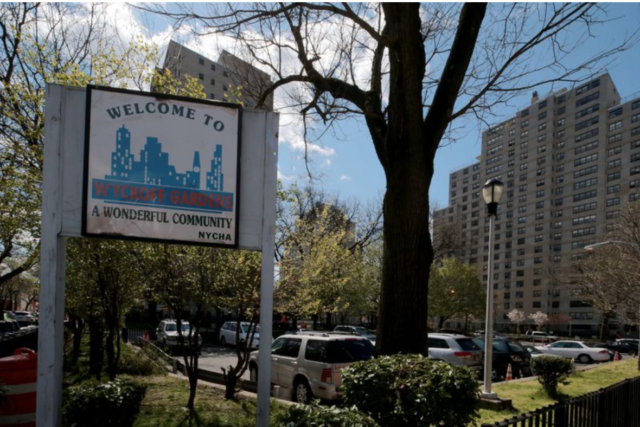
The Wyckoff Gardens Houses in Brooklyn. April 22, 2020.(Luiz C. Ribeiro/for New York Daily News)
By Saundrea Coleman and La Keesha Taylor
April 29, 2020
Finding your son sitting in his bedroom with blood running down his face never gets easier, though you’d think we’d be a bit more used to it by now. As mothers of children struggling with asthma and frequent nosebleeds from excessive heat and broken boilers that do not properly regulate temperatures, some of us opt to forgo heating our homes entirely. It gets cold in the winter, and corroded pipes burst from time-to-time, but with few choices, you learn to make due. That is, until coronavirus moved in.
As residents of the Holmes-Isaacs NYCHA campus, we can attest to the well-documented chronic lack of repairs and proper maintenance of NYCHA buildings, as well as woefully inadequate sanitation and poor communication from the Housing Authority.
Decades of disrepair and disinvestment in public housing are exacerbating pre-existing health conditions — like heart disease and diabetes — that put NYCHA residents at particularly high risk of COVID-19-related hospitalization and death and put all tenants at greater risk. Tenants regularly experience water outages and hot water disruptions, making handwashing and proper disease prevention difficult. Frequent, extended elevator outages make social distancing impossible.
The Housing Authority has a federally appointed monitor. Under the monitor agreement, the agency has made many promises, including to more swiftly remove poisonous lead paint, eradicate toxic mold and upgrade thousands of unreliable elevators. We’re still waiting.
With the support of Justice Center en El Barrio and attorneys provided by TakeRoot Justice, we’ve taken legal action in December for NYCHA’s failure to maintain safe conditions inside the buildings. In January, the court ordered NYCHA to make improvements and follow the standards in housing laws.
But NYCHA is failing to do so. We have been back in court twice, once in February in person and once via a remote appearance that is the new process for housing emergencies in the time of COVID-19; each time, the judge has urged NYCHA to make and show progress. But conditions continue to deteriorate, even amidst increasingly urgent concerns over COVID-19.
Residents have been stranded by complete elevator outages, trapped inside broken elevators or left with a single elevator for the entire building.
NYCHA promised to provide regular, more frequent and thorough sanitation and maintenance for our buildings. That hasn’t happened. Many of the workers NYCHA hired to sanitize don’t have personal protective equipment needed to keep us or themselves safe. Many also don’t seem to have proper training on how to sanitize for COVID-19 prevention. This clearly is not the workers’ fault; it’s a failure of NYCHA leadership.
All of this is worse by NYCHA not communicating with tenants or being transparent with us throughout the process. Posting information online and in building lobbies is not enough for residents to receive important information — especially when we’re trying to maintain social distancing and dealing with the chronic elevator outages. At a minimum, flyers should be posted on each floor and residents should receive mailings from NYCHA with important information.
Although it’s hard to think of worse living conditions than those we’re currently experiencing, things surely would be worse under private management, which would be motivated to cut corners to turn a profit. Rather, NYCHA must fulfill their responsibility to keep the 1 in 15 New Yorkers who live in public housing healthy and safe. To help ensure that NYCHA can fulfill its duty, federal, state and local governments should prioritize safe, quality housing as a human right and fully fund NYCHA.
Coleman and Taylor are resident leaders and co-founders of the Holmes-Isaacs Coalition.
